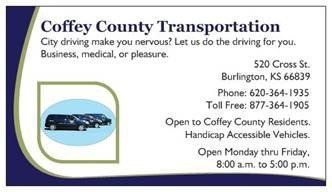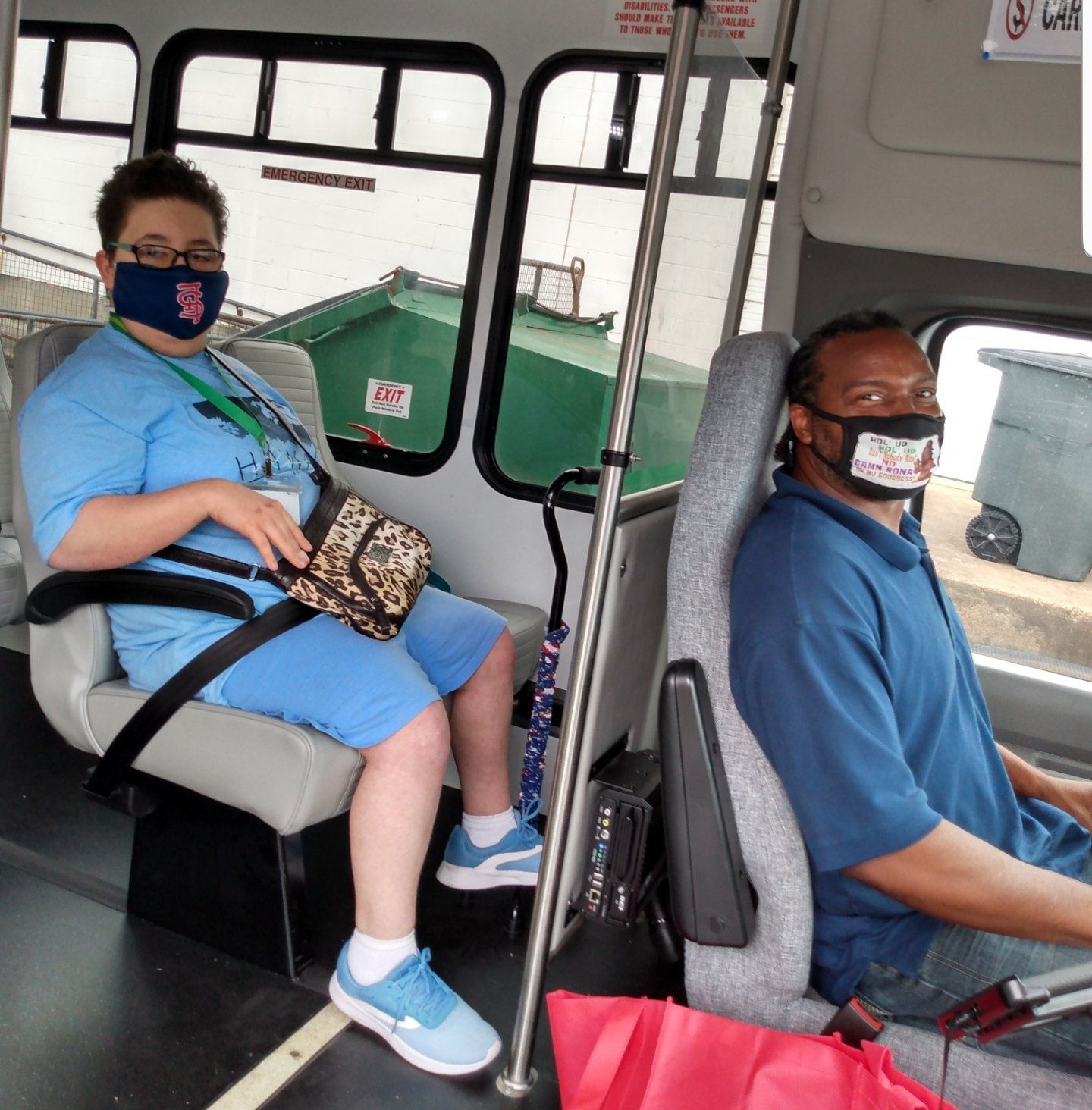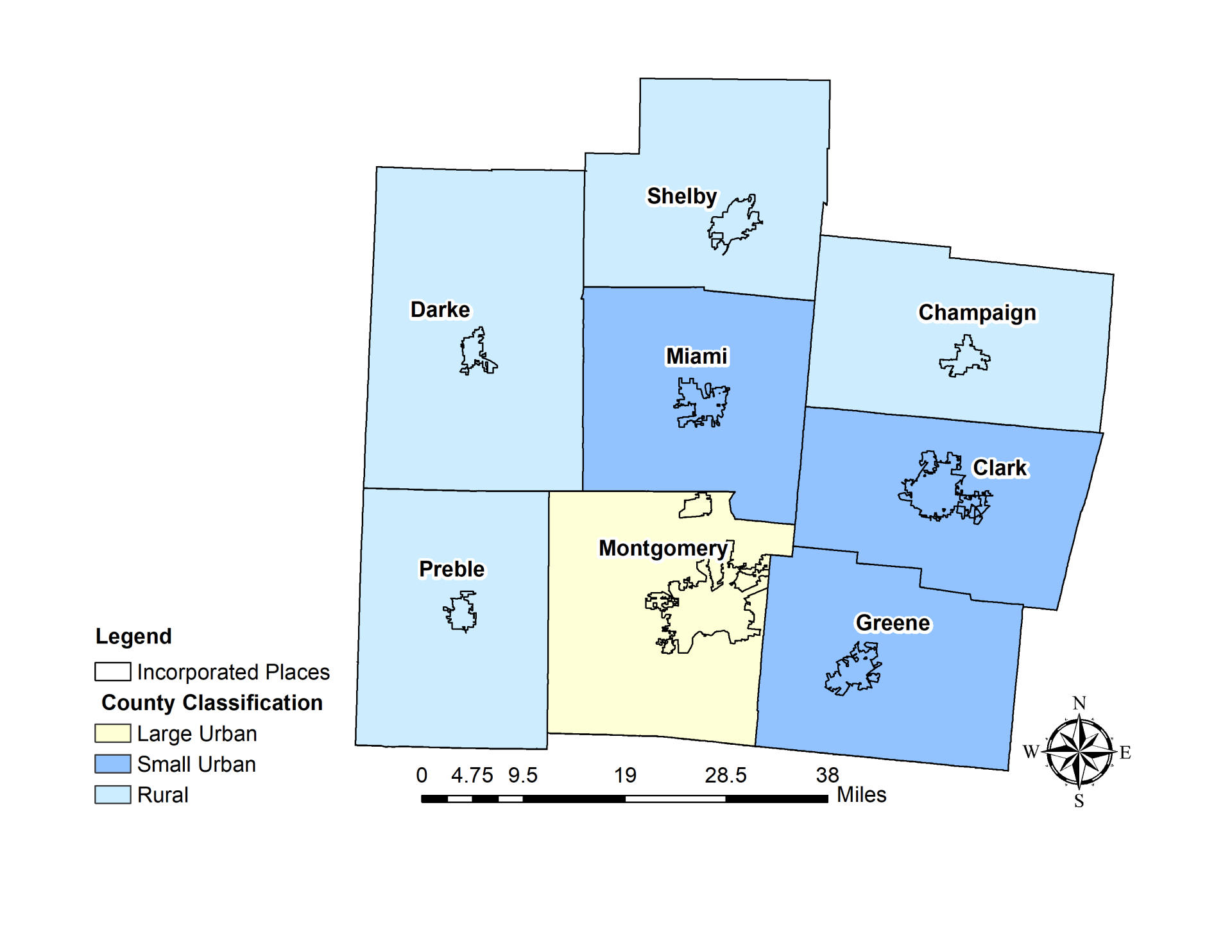Recently there have been several new nursing home aides and because of the pandemic, an in-person meeting to review transportation policies was not allowed. Kara created a business card with contact information on one side. Aide responsibilities and a few Rules of the Bus are on the back side. Drivers pass these out to the aides when they board the bus.
Sharing Training with Agencies Coordinating Transportation
RESOURCES > INFORMATION
Sharing Training with Agencies Coordinating Transportation

Greene CATS Public Transit Riders
Photo Credit: Shannon Webster, Greene County Mobility Manager
Introduction
According to the National Center for Mobility Management (NCMM), “Coordinated transportation services are achieved when multiple entities work together in delivering one or more components of a transportation service so they can increase their capacity to provide trips.” Coordinating transit planning efforts with human services transportation and other types of service can reduce the burden of planning efforts and combine the development of several separate plans into a single combined plan. Like transportation coordination itself, sharing training practices and resources among agencies in a coordinated system will take time and commitment. But giving the time and commitment to proper training is worth the effort. Successful training:
- enables employees to perform assigned tasks efficiently
- introduces a new behavior or modifies an existing one
- minimizes individual differences in skills, knowledge, and attitude
In National RTAP’s Rural Transit Training Twitter Chat, moderator Stephanie Lewis, Instructional Designer/Media Specialist, Center for Urban Transportation Research (CUTR), stated that “training assists in developing a safe atmosphere for drivers and riders, improves quality of service, and provides a positive experience for passengers.”
In their Montana Coordinated Transportation Handbook, the Montana Council on Developmental Disabilities has identified several benefits for joint training for coordinated systems:
- Training employees in larger groups can lead to lower individual costs of training programs.
- Training employees in larger groups can provide access to some training programs that may not be available to small groups or individuals.
- Joint training allows employees from different agencies to get together, share ideas, and network, which helps boost morale.
- Joint training programs for different agencies ensure a consistent transportation experience for customers in the service area.
- Joint training can help simplify vehicle and trip sharing arrangements by preparing drivers from participating agencies to operate vehicles from all other agencies and understand the special needs of customers from all other agencies.
- Joint training can also pave the way for future coordination at higher levels
Though some overlap in the content of coordinated system training programs may occur, training can and should be tailored to the needs of the specific agencies and employee groups involved in the coordinated service. Some coordinated systems require all drivers, including volunteer drivers, to be trained through the transit provider.
The following case studies provide best practices on developing shared training for drivers, dispatchers, managers, riders, and others across agencies that coordinate transportation.
Case Studies
Coffey County Transportation, Kansas
Coffey County Transportation provides public transportation in and around Coffey County, Kansas. They are also the sole transportation provider for their local nursing home. Executive Director Kara Reynolds attended a staff meeting with the nursing home employees and talked about what the responsibilities of the aides are and what the responsibilities of the transportation staff is. At the time, the aides had many questions about what their responsibilities were and what the drivers’ responsibilities were. Kara created and shared with the nursing home staff a “Who’s responsible?” chart. She also shared the chart with her own staff at transportation so they would be on the same page as the aides.

WHO’S RESPONSIBLE?
- Pushing the client’s wheelchair out of the facility, onto the ramp/lift, and into the bus?
- The aide.
- Transferring client to a seat?
- The aide.
- Moving the client’s foot/feet out of the way?
- The aide.
- Strapping down the wheelchair and making sure it is secure?
- The driver.
- Putting the seatbelt on the client?
- The driver and the aide should work together.
- Running the ramp up and down, either with the black box or by pumping?
- The driver.
RESPONSIBILITIES OF CLIENT AIDES:
- Help client on and off of bus.
- Be attentive to client needs on bus.
- Advise driver if need to stop arises.
- Transfer of client from wheelchair to seat.
RULES OF BUS:
- Bottled Water Only – No food or other drinks.
- Seatbelts required.
- Federally Mandated Mask Requirement.
- Driver to secure wheelchairs.
- See Passenger Guidelines for full list of bus rules.
OATS Transit, Missouri
OATS Transit, a 501(c)3 nonprofit corporation providing transportation to 87 counties in Missouri, provides specialized transportation for thousands of Missourians, including the rural general public, seniors, and people with disabilities. OATS Transit coordinates transportation for more than 200 agencies around the state, some of whom have special training requirements. One such agency is the Productive Living Board for St. Louis County.

The Productive Living Board is a Senate Bill 40 Board that contracts with agencies like OATS Transit to serve individuals with developmental disabilities in St. Louis County, MO. Through Productive Living Board and OATS Transit, around 250 people receive rides to and from sheltered employment on an annual basis. This partnership has been in place for more than two decades to ensure individuals with disabilities have a safe, reliable way to get to work.
The Productive Living Board requires that the agencies they contract with have specialized training geared toward the clients they serve. Training for the OATS Transit drivers is conducted internally based on guidelines developed by the Productive Living Board. All drivers that serve clients of the Productive Living Board must take these training classes. The East Region of OATS Transit provides this training to all drivers as part of driver orientation, with refresher training performed annually. Training includes service expectations, human rights, sensitivity, incident procedures and reporting, fraud, waste & abuse, and other policies and procedures. Additionally, drivers are required to undergo CPR and first aid training every two years as part of this partnership agreement. OATS Transit staff ensures compliance with all required training.
Miami Valley Regional Planning Commission (MVRPC), Ohio

The Miami Valley Regional Planning Commission (MVRPC) performs planning and research functions for their Region that ensure livable and equitable communities; clean air and water; robust roadway, transit, and active transportation options; and strategic community plans for member communities and partners. As the designated Metropolitan Planning Organization (MPO), MVRPC is responsible for transportation planning in Greene, Miami, and Montgomery Counties (map shown at right) and parts of northern Warren County.
MVRPC also works in partnership with the Ohio Department of Transportation (ODOT) on a regional transportation coordination initiative. This includes a network of transportation providers and mobility managers across an eight-county region that have come together to form a Human Services Transportation Coordination Council. The council hosts quarterly meetings to discuss transportation challenges across the region as well as identify training opportunities for the entire network.
A unique aspect of regional coordination allows for opportunities to provide training at an affordable cost to council members. The region’s mobility managers are certified to provide DRIVE: Transporting Older and Disabled Passengers training, a specialized course developed through the Ohio Department of Aging to train those who transport older adults and individuals with disabilities, as well as Defensive Driving to transportation providers in the network, at no cost due to grant funding. The mobility managers obtained certifications through the Ohio Department of Aging and the National Safety Council. The regional structure also allows the mobility managers to provide training across county lines to agencies regardless of their urban, small urban, or rural status. Trainings offered to transportation providers keep drivers up to date on best practices and safe driving standards to ensure riders reach their destinations safely. Since the regional coordination initiative was adopted in 2020, over 40 drivers have been educated with DRIVE training and Defensive Driving.
The mobility managers also offer a variety of educational opportunities to riders at no cost, including Travel Training courses. Their programs allow the mobility managers to teach people with disabilities, older adults, and interested travelers how to use public transportation independently and safely. By offering services at a regional level the mobility managers have the flexibility to support one another to supplement training opportunities to ensure every passenger has the skills and confidence to access transportation. Regionally, over the last two years, more than 100 individuals have been educated on using public transportation.
Additional Promising Practices
TCRP’s Toolkit for Rural Community Coordinated Transportation Services includes many case studies of coordinated services. Several of them discussed how they coordinated training. For example, Ride Solution in Western Indiana, sponsored by Four Rivers Resource Service, Inc., educated residents who knew little about public transportation through newspaper articles and in-person presentations.
A National Aging and Disability Transportation Center (NADTC) case study, Partnering Across County Lines described how Valley Regional Transit (VRT) partner agencies were able to use the VRT scheduling software to schedule trips more efficiently. Originally, VRT scheduled all trips. That soon became overwhelming as the suite of services and providers grew. Several agencies were established as sub-users and VRT began training their partners’ personnel to schedule their own trips.
How eLearning can Help
eLearning, sometimes called Distance Learning, is an affordable solution that allows learners to access training remotely using a computer, tablet, or smartphone. Because eLearning is not limited by geographic constraints, it provides training opportunities in situations where access to instructor-led classroom training is difficult or not cost-effective. Employees with scheduling or distance problems can benefit because eLearning can be more flexible in terms of time and can be delivered almost anywhere.
The National RTAP eLearning portal is a Software as a Service (SaaS) that is hosted on the easy-to-use Learning Management System (LMS) platform. The eLearning portal allows transit employees to take self-guided, online courses on topics such as emergency management and general refresher trainings such as distracted driving and defensive driving. New and updated trainings, both National RTAP courses and links to outside trainings, are added to the portal regularly. Transit managers can easily obtain reports that document employee training, as well as assign online courses in lieu of, or in addition to, in-person instructor-led training (ILT).
National RTAP eLearning is available for free to all rural and tribal transit agencies, and to organizations that coordinate rural and/or tribal transit services. One or more individuals from the coordinated service can be designated as eLearning administrators and oversee the learning of all individuals throughout the service.
Tips and Techniques for Sharing Training
- Develop relationships with neighboring agencies/geographic areas to establish a means of sharing upcoming training sessions.
- Identify learning facilities within the coordinated system where people from other agencies can be accommodated. Consider community colleges, training centers, Head Start program offices, alcohol, and other substance abuse program facilities, senior centers, libraries, nutrition sites, and personal care sites.
- Organizations beyond the coordinated system, such as Red Cross facilities or police and fire departments, may be able to offer space and/or trainers to all. Technology vendors may be able to provide training to all stakeholders on their products, such as dispatch software.
- Have one person in the coordinated service take the reins for one training and then have someone else take over for the next training.
- Consider assigning one agency or organization the responsibility of assessing the training resources of all the partners. If one participant is planning the training for the entire coordinated system, they should ask other participants for feedback and suggestions. Alternatively, one participant can find the training facility, and another can find training courses and materials, etc.
- Private training companies that prepare drivers to take a Commercial Driver’s License (CDL) test may charge a high rate per driver. By coordinating this type of training with other systems, and increasing the total number of participating drivers, the coordinated service may be able to negotiate a lower driver CDL training fee.
- Remember that every system is different. What works for one partner may not work for another.
Statewide, regional, and national conferences offer many training opportunities. RTAP funds are often available to send staff. - Reach out to the State RTAP Manager and National RTAP for high-quality training resources.
Acknowledgements
National RTAP is grateful to the following individuals for their contributions and reviews: Elizabeth Baxter, Miami Valley Regional Planning Commission; Kara Reynolds, Coffey County Transportation; Jill Stedem, OATS Transit
Further Information
Montana Council on Developmental Disabilities. Montana Coordinated Transportation Handbook. 2003. mtcdd.org/coordinated-transportation-handbook
National Academies of Sciences, Engineering, and Medicine. 2004. Toolkit for Rural Community Coordinated Transportation Services. Washington, DC:
The National Academies Press.
National Aging and Disability Transportation Center (NADTC). Partnering Across County Lines – Valley Regional Transit. 2020. https://www.nadtc.org/resources-publications/resource/partnering-across-county-lines-valley-regional-transit/
National Center for Mobility Management (NCMM). Transportation Coordination Resources.
https://nationalcenterformobilitymanagement.org/by-topic/coordination/. Accessed November 2, 2021.
National RTAP.
eLearning.
National RTAP.
Rural Transit Training Twitter Chat Summary. 2021.

National RTAP offers one-stop shopping for rural and tribal transit technical assistance products and services. Call, email, or chat with us and if we can’t help with your request, we’ll connect you with someone who can!
" National RTAP offers one-stop shopping for rural and tribal transit technical assistance products and services. Call, email, or chat with us and if we can’t help with your request, we’ll connect you with someone who can! "
Robin Phillips, Executive Director
" You go above and beyond and I wanted to let you know that I appreciate it so much and always enjoy my time with you. The presentations give me so much to bring back to my agency and my subrecipients. "
Amy Rast, Public Transit Coordinator Vermont Agency of Transportation (VTrans)
" I always used the CASE (Copy And Steal Everything) method to develop training materials until I discovered RTAP. They give it to you for free. Use it! "
John Filippone, former National RTAP Review Board Chair
" National RTAP provides an essential service to rural and small transit agencies. The products are provided at no cost and help agencies maximize their resources and ensure that their employees are trained in all aspects of passenger service. "
Dan Harrigan, Former National RTAP Review Board Chair
" We were able to deploy online trip planning for Glasgow Transit in less than
90 days using GTFS Builder. Trip planning information displays in a riders'
native language, which supports gencies in travel training and meeting Title VI
mandates. "
Tyler Graham, Regional Transportation Planner Barren River Area Development District
Slide title
" Having a tool like GTFS Builder is really light years ahead of what it used to be at one time in terms of how fast you can put everything together. Our university students really can't imagine transit without it, so I think it's very important for us in terms of attracting that particular demographic. "
Michael Lachman, Transportation Services Manager HAPCAP - Athens Transit
Slide title
" In the past we used proprietary database software that was very challenging, very murky, and hard to update. GTFS Builder is a great opportunity to make this more user-friendly, more readily updatable and it
would enable us to show how to create a GTFS to more of the staff. "
Jaime McKay, Former Manager of Direct Services Center for Mobility Equity
Slide title
" Collaboration is a buzz word these days in the industry. On behalf of our Tribal segment, I appreciate RTAP for making Tribes a partner in industry opportunities. The organization goes over and beyond reaching partners one would not expect in a busy industry such as public transportation. Thank you for your tireless efforts! "
Franklin Akoneto, Comanche Nation
Slide title
"We are so very thankful for all your transportation training materials. Your resources are as valuable as gold!"
Holly Walton, Transportation Assistant Manager, Curative Connections
A program of the Federal Transit Administration administered by the Neponset Valley TMA
National RTAP is committed to making this website accessible to persons with disabilities. If you need assistance accessing any content on our website or need alternative formats for our materials, please contact us at info@nationalrtap.org or 781-404-5020.
by National RTAP |

